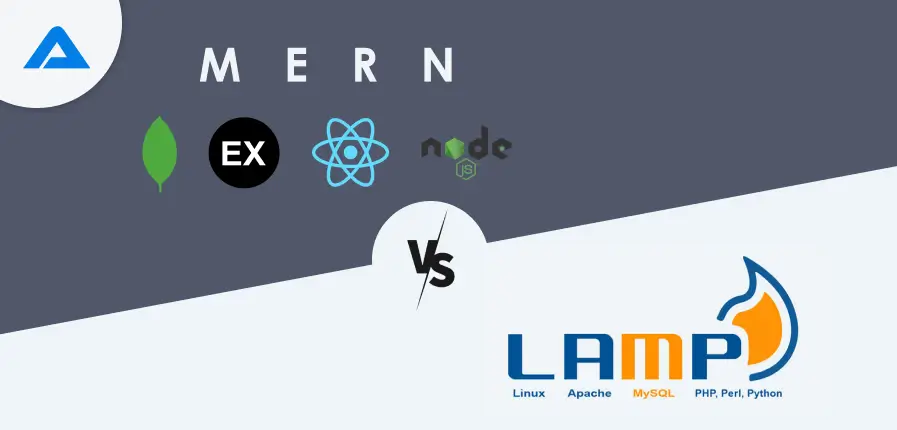If you’re beginning a new venture, the tech choices are only sometimes straightforward, and deciding on the best Full-Stack development stack can be one of those difficult decisions. Today, we’ll examine the MERN and LAMP stacks of technology to build software solutions.
In today’s technologically fast-paced environment, selecting the best development platform to build your application is vital. With the many choices available, it can be challenging to choose the right one. Two stacks that developers frequently consider are LAMP and MEAN.
We’ve got the latest smartphones, smartwatches, and earphones. We also have fitness trackers and AI-enabled devices. You can also find electric cars!
Stack is the clear leader in the mobile and web application solutions development market. Choose the best stack for your project, and you’ll be on the right track to be successful!
What is a Development Stack?
The development stack can be more than an assortment of components for software. It’s a carefully selected combination of technology that works seamlessly to build an efficient and robust web-based application. Each layer plays a particular role and plays a role in the overall performance of the app.
An operating system is at the heart of the stack, supplying the required infrastructure for applications on the Internet to function. The choice of an operating system is based on aspects like security, performance, and compatibility with other stack components.
Web servers are accountable for handling client requests and providing the correct responses. Popular web servers include Apache, Nginx, and Microsoft IIS. The choice of a Web server is based on factors like performance, scalability, and the ability to support specific features demanded by the software.
It is the layer that handles the database to store and retrieve information. There are various databases, including relational databases such as MySQL and PostgreSQL and NoSQL databases such as MongoDB or Cassandra. The database you choose depends on factors that influence it, such as the structure of data, its scalability, and performance requirements.
The framework or programming language employed within a development stack decides how application logic is executed. PHP, Python, Ruby, and JavaScript are the most popular programming languages. Frameworks such as Laravel, Django, Ruby on Rails, and Node.js offer additional tools and libraries that reduce development time and improve efficiency.
Importance of Choosing the Right Stack
Selecting the best development stack is vital to the successful development of any project. Each stack has unique advantages and disadvantages, so choosing the correct one can significantly affect factors like speed of development, scalability performance, and maintenance. Before deciding, it is crucial to consider your application’s needs, the experience of your development team, and your app’s goals for the future.
Development speed is a key factor to consider when selecting the right stack. Specific stacks provide rapid development capabilities, which allow developers to build and test applications. This is beneficial in projects with short deadlines or when time-to-market is essential.
Another aspect to consider is scalability. If your application expands and draws more users, the stack needs to be capable of handling the increasing demand without sacrificing performance. Certain stacks have scaling features, like clustering and load balancing, which provide a smooth user experience, even in high-traffic conditions.
Performance is a crucial element of any web-based application. The choice of stack used can determine how fast the app responds to user requests and how efficiently it uses the system’s resources. Things like the effectiveness of the framework or programming language, how well the server performs, and the efficiency of database queries all affect the app’s overall performance.
Maintenance is a continuous process for all web-based applications. The selected platform has a vibrant and active community that offers periodic updates, bug fixes, and security patches. In addition, the availability of tutorials, documentation, and support resources can significantly simplify maintenance and help developers resolve issues faster.
What is MERN Stack?
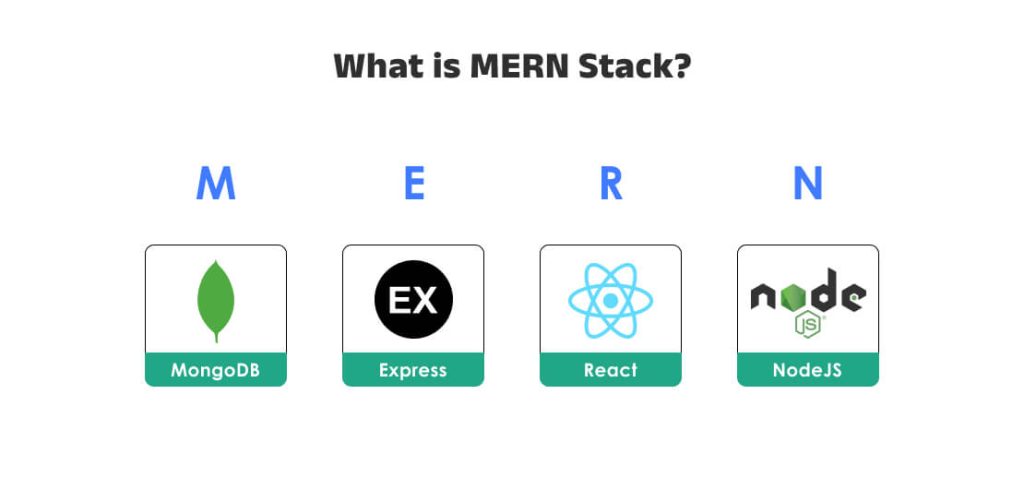
MERN stack development services are the abbreviation of MongoDB, Express, React, and NodeJS. It’s a platform based on the well-known programming language JavaScript and its application framework JavaScript. It allows for the development of powerful user interfaces for front-end use through React, which manages back-end development using Node.js and Express.js and then places it into an online database with MongoDB.
MongoDB
MongoDB is a reliable open-source multi-platform NoSQL database designed to simplify database interaction, storage retrieval, and modifications. It also offers scalability and high availability for application development.
Express
Express is a renowned Node.js server-side framework that is beneficial if you hire dedicated NodeJS developers to craft reliable websites, online apps, and APIs. In addition, Express provides a simple method of routing codes into modules.
React
React is a tool for developing User Interfaces that developers can reuse to create Front-End Web Applications for efficient rendering. The JavaScript-based application allows for changing views as data changes occur while making it easier to manage.
Node
Node is a server-side JavaScript runtime environment that allows developers to write server-side software using the same front-end software.

Want to build something incredible? Hire our expert MERN developers today and unlock the full potential of this powerful stack.

Pooja Upadhyay
Director Of People Operations & Client Relations
What is the MERN Stack Function?
MERN’s operational process uses an approach with three layers to handle front-end, back-end, and database support. Each technology serves a purpose, including MongoDB storage of data and Express running APIs. React is a tool for creating interactive user interfaces. Node creates the runtime environment to build fast and efficient web-based applications.
Top 5 Benefits of MERN Stack
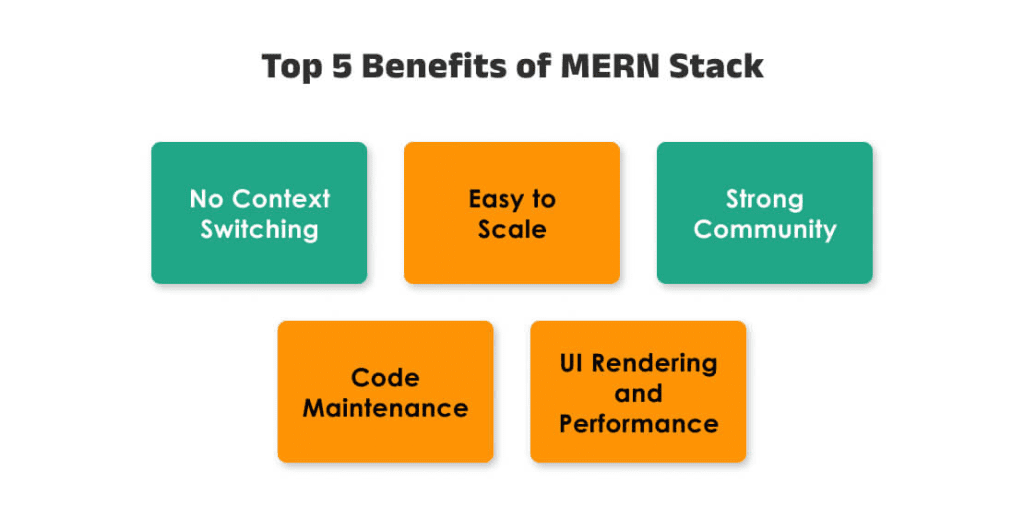
At this moment, it’s clear that the MERN stack is one of the top priorities when creating websites or apps. It’s cross-platform, versatile, and user-friendly – all aspects that make it an ideal choice to meet your requirements. Hire MERN, the company that develops stacks for all your requirements.
No Context Switching
One of the main advantages of the MERN stack is that it incorporates Node.js, Express.js, React.js, and Node.js into a single platform. It allows you to develop your app’s back-end and front-end simultaneously without any delays or compatibility issues due to using different languages for the various parts of your app’s structure. You can hire a MERN stack developer who can use both languages. There’s one person who can do it all!
Easy to Scale
MERN is an open-source JavaScript framework for building mobile and web applications. Its modular structure makes it simple to create applications that scale with microservices, i.e., tiny modules or units in the system designed to complete one particular task, maximizing performance and efficiency.
Strong Community
The most obvious benefit is the strong community. Its open-source nature stack ensures that you will always find someone willing to assist you whenever you require assistance. Also, there is a wealth of instructional videos and code snippets to use as a foundation for your next project.
Code Maintenance
The JavaScript ecosystem is vast and unique, but it can be challenging to stay up-to-date with the new libraries released daily. This is where Code Maintenance comes in. Code Maintenance automatically updates your library dependencies according to your package.json file and executes the appropriate commands to upgrade them.
UI Rendering and Performance
React JS is an excellent choice for UI abstraction because it’s a library that allows you to create your application however you’d like. It’s better than Angular when it comes to UI processing and speed.
What is LAMP Stack?
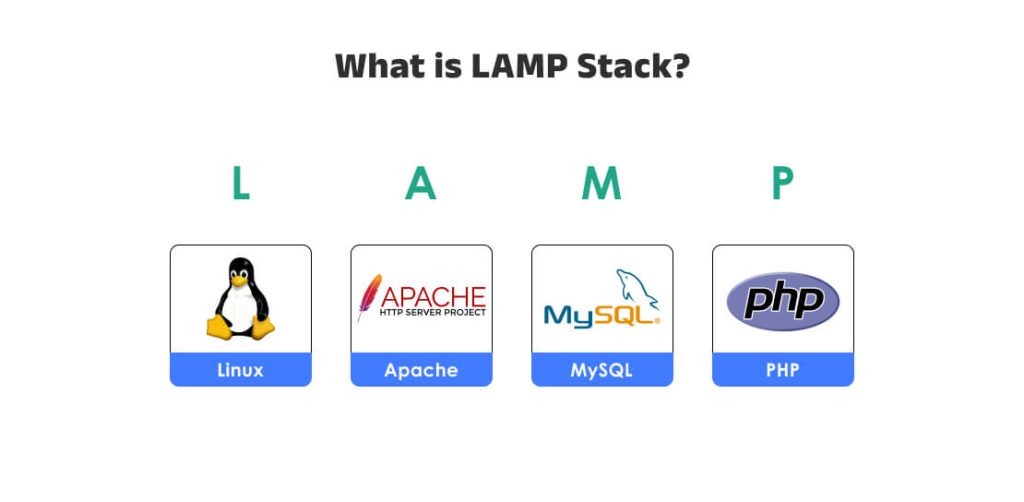
LAMP is a blend of open-source software utilized to build websites. It is the acronym for Linux, Apache, MySQL, and PHP (sometimes the abbreviation P can also be applied to the terms Perl and Python). These components allow users to build and manage websites and web-based applications.
Linux
Linux is a free, open-source OS that runs on personal computers, embedded systems, and servers. It ensures that only authorized users can access files.
Apache
Apache is a freely available web server application. It is used to manage websites and web-based applications. It’s a secure, reliable, and efficient method to make websites available online.
MySQL
MySQL is a free-of-cost relational database management system that employs principles of SQL (Structured query language).
PHP
PHP (Hypertext Preprocessor) is a popular open-source server-side scripting language for dynamic web applications.

What is the LAMP Stack function?
LAMP is an open-source Linux-based stack that integrates various open-source software to function efficiently. Linux is the system that allows all technicians to perform their work.
While Apache hosts websites and applications that use software, MySQL is a database layer that stores and retrieves data from tables and lets users interact with them using SQL queries. Additionally, PHP (or Python) is the back-end language for creating dynamic platforms. This makes it an ideal choice for projects that require speedy development.
Benefits of Lamp Stack
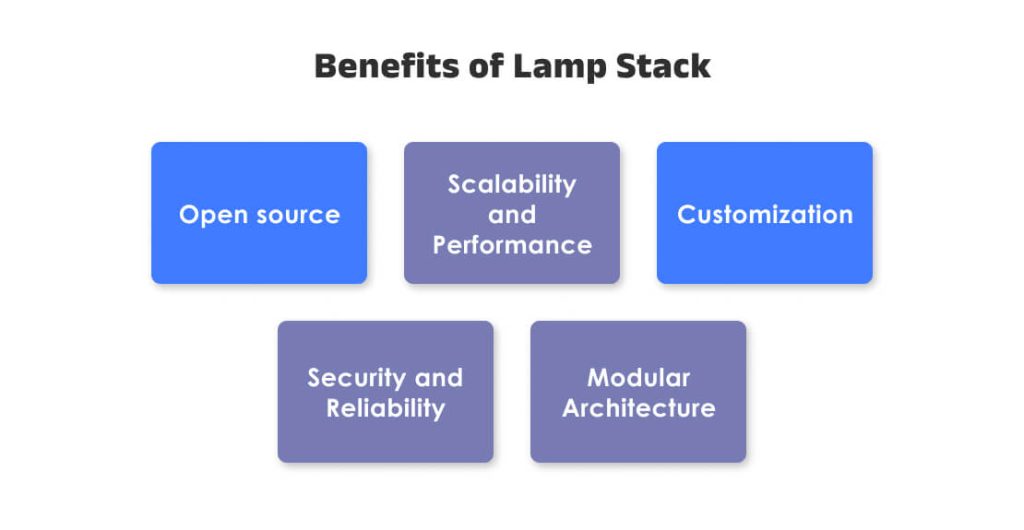
It is important to remember that when you engage a Lamp, the company that develops stacks, Lamp stack developers, or Hire Lamp Stack development team, they’ll create the software to meet your specifications and requirements. Here are the benefits you will take advantage of when you choose Lamp to develop your stack as a platform for solutions.
Open source
The Lamp stack can be described as a cost-free and free software stack. A collection of programs creates dynamic websites, applications, and web services. It’s commonly known as LAMP because it comprises Linux, Apache, MySQL, and PHP (or Perl). The name derives from the first letter of every word.
Scalability and Performance
The LAMP stack is an assortment of open-source software applications designed to help web developers deploy. The acronym LAMP means Linux, Apache, MySQL, and PHP. These software programs are capable of bringing scalability and speed to your website. The main benefit is that its open source LAMP stack is open source, which means that the LAMP stack lets you alter the software’s code according to your needs and is free to modify it.
Customization
In addition, we can customize our stack and swap its components with open-source programs to fulfill our specific business needs. Furthermore, Apache is modular in its design, meaning that you will locate different modules that could be modified to meet our requirements.
Security and Reliability
As a web and mobile application developer, you must secure your user’s information. You do not want to be the person who is responsible for security breaches. When you use LAMP and the LAMP stack, you will relax and be assured that your website is secure from hacks and will be stable regarding uptime. The three components work to keep your website operational if you combine Apache, MySQL, or PHP.
Modular Architecture
The LAMP stack is an open system comprising the Linux operating system Apache HTTP server MySQL, MariaDB database, and PHP programming language. While it’s not the sole combination of components used to create dynamic websites and applications, the LAMP stack is now among the top and most well-known because it’s open source and free of charge. It benefits developers since they can choose the components without worrying about compatibility concerns.
MERN Vs. LAPM: A Detailed Comparison
After we’ve explored the various components, advantages, and disadvantages of each stack, let’s look at how we can compare them based on a few crucial aspects:
Operating System
The operating system that runs the LAMP stack is “Ubuntu,” while the MERN stack makes use of a mix of five distinct technologies, i.e., Node.js, Express.js, AngularJS, MongoDB, and Node Package Manager (NPM). When it comes down to which one is superior, both of them run using Linux. This is since the MERN stack makes use of the latest versions of all the technologies in its framework. This makes it stronger, more robust, more stable, and much simpler to manage, particularly regarding deployment.
LAMP Stack was initially explicitly developed for Unix-like operating systems, which means it runs on any PHP platform without significant issues. However, the MERN stack is much better because it runs the most recent version of Node.js, allows it to be cross-platform, and runs on any device with JavaScript support without issues.
MERN stack has an enormous advantage over LAMP because of the latest versions, stability, speed, ease of use, and the variety of languages that can be used to develop. This is why the demand for MERN stack development firms has increased dramatically.
App Type
The type of app used for the LAMP stack is “Dynamic,” while the MERN stack uses a combination of three distinct kinds: “Static,”” SOAP,” and “WCF/RESTful.”
If you compare LAMP against its counterpart, the MERN stack, the services provided by “WCF/RESTful” are dynamic since they are customizable to meet users’ requirements. WCF is more of an application framework, while RESTful is an architecture style that makes it simple to integrate.
The two other types, SOAP and RESTful service, respectively, are “Static” in nature. SOAP can be described as a method that allows requests and responses based on XML. RESTful services rely on an HTTP protocol to connect to Web services.
Lifetime
The life span of both applications is vastly different. While it depends on the variety of web design companies you’ve chosen to work with, we will compare these two apps based on the general parameters.
The most important thing is that LAMP has existed for a longer time than the MERN stack. This means many developers and businesses have had experience developing applications on this LAMP stack. Additionally, more developers are willing to share their code because it’s an open-source platform.
The second aspect is that the MERN stack is upgraded each time Node.js is updated to make it faster and more stable. It is also secure, which results in an enhanced user experience. This means that the life span of the LAMP stack diminishes with time because of these updates to Node.js.
Traffic
Indeed, the MERN stack is super-fast and extremely reliable. However, regarding the huge volume of data, the heavy requests, speed, and stability.
The MERN stack has become the most popular choice of many businesses. It offers a distinct advantage over LAMP because it handles dynamic and static data from databases, which aids with high-level traffic. However, because it runs Node.js, it isn’t compatible with a large volume of stored data or large requests, losing some of its advantages over LAMP.
Because of its MySQL compatibility, the LAMP stack can be the most suitable option for handling high traffic and heavy loads. Additionally, its ability to handle both dynamic and static queries from databases makes it an ideal alternative to MERN.
Client & Server Side
Client-side web applications have many advantages over server-side apps, which makes their web development solutions simple and quick. The primary benefit of a client-side app is that it is light, meaning it’s faster, provided you have a reliable internet connection. It also has the beautiful benefit of monitoring user behavior and analyzing data in real-time, making it more flexible.
MERN is slower and has fewer speedy updates, which reduces its lifespan and offers fewer possibilities for development on the client side.
LAMP is the most suitable option for creating a web app for clients, with MERN being the second most popular option.
Dynamic or Static
Both are equally competent in handling static data. However, when we look at dynamic web pages that need server feedback as the page is loaded, the process becomes more complicated for both stacks.
There are various situations in which the information on a web page constantly changes, making it difficult to know what type of information the visitor will present. To accomplish this task, the MERN developer must develop code that could update pages without reloading them, making development more time-consuming and creating a space for errors.
There are numerous instances when the content of a website page constantly changes, making it difficult to determine what kind of information will be provided for the end user. For this job, a MERN developer must create code that updates pages without loading them again, making development more time-consuming and creating space for errors.
Training
Many developers have attended training sessions because the LAMP stack is very long-standing. In addition, many books on the LAMP stack by professionals help novices understand it efficiently.
However, MERN has become quite popular in a relatively short period. This means that fewer developers are familiar with the MERN stack. Yet, MERN web developers are more efficient in providing services.
Maintenance
Each stack is equally simple to maintain, especially for smaller projects. However, if we look at larger-scale projects with many developers, MERN has a slight advantage over LAMP because it runs JavaScript as the sole language that can rule all.
Therefore, if a developer has mastered JavaScript well, they can effectively work on front-end and back-end development without needing to learn different programming languages for back-end and front-end.
Security
The LAMP and MERN stacks are equally safe for small-scale projects. However, when we consider larger projects with several developer teams, MERN has the edge over LAMP as the MERN developers employ only one language, JavaScript. This allows them to work within the same team.
Cost-Effectiveness
Both stacks are economical for small-scale projects. MERN is a better option for large-scale projects with many developer teams since JavaScript is a single language. MERN utilizes only one web framework: Express.js.
In the LAMP stack, different components are used for back-end and front-end development, meaning you’ll need to purchase the licenses for both frameworks.
Scalability
Since both stacks offer roughly the same capacity, the choice depends on features and usability. If your application needs more capabilities, you could opt for the MERN stack, which is easily scalable compared to the LAMP stack.
If the project is unimportant, you could opt for the LAMP stack, which has a lower learning curve and superior performance.
Community
The LAMP stack is believed to be more supported than the MERN stack due to its longevity. It has been utilized for many years by developers across the globe, which means it has a vast community, which makes it simple to get help if you’re stuck in a particular area. However, MERN has just started developing its community, which means it’s not as popular.
Customizability
The LAMP stack and the MERN stack are customizable in their ways. However, the LAMP stack is mostly customizable using add-ons or PHP frameworks such as Symfony and Zend. However, MERN can be customized by hot reloading. That is, you can modify your code without restarting your application.
Performance
It is a better option if speed and efficiency are the primary concern. A great framework like Express.js lets you build high-performance web-based applications in minutes. However, the LAMP stack lacks specific frameworks designed explicitly for back-end development. As a result, it is not as fast as the MERN stack in terms of performance.
Flexibility
Both stacks permit you to develop web applications with a variety of options. The only difference is the amount of flexibility offered by these frameworks. MERN stack is the better option for full-stack JavaScript development due to its great flexibility at the front-end and back-end levels. This means that you can create full-fledged JavaScript applications quickly. However, LAMP can make full-fledged web-based applications but with little flexibility.
The Key Takeaway
Your venture’s success depends on your choice of technology stack within the evolving Web applications development industries worldwide. Employ MERN stack developers based on your project’s needs and goals to determine whether it’s a good idea to choose the MERN and LAMP stacks.
The MongoDB, Express, React, and Node stack that powers MERN offers unrivaled versatility and creativity in JavaScript-based programming. In contrast, its LAMP stack, consisting of Linux, Apache, MySQL, and PHP, provides a stable and well-supported platform that allows online apps.
Each stack will have its strengths, depending on whether performance, scalability, or usability are your top priority. While LAMP is ideal for those who appreciate stability, support, and cost-efficiency, MERN is best for those seeking the latest technology, speed, and full-stack capabilities.
Frequently Asked Questions
When it comes to modern web development, MERN (MongoDB, Express.js, React, Node.js) is often regarded as superior to LAMP (Linux, Apache, MySQL, PHP) due to its utilization of JavaScript throughout the entire stack. This integration streamlines the development process and simplifies the management of both front-end and back-end development. Furthermore, MERN’s non-relational database (MongoDB) provides versatility in handling extensive amounts of unstructured data, which proves advantageous for applications that undergo frequent changes.
The primary advantage of utilizing a LAMP stack is its consistent and dependable performance. LAMP has remained a favored option for web development for many years, offering a solid foundation for creating and launching dynamic websites and applications. It leverages many tools and a thriving community, ensuring that resources and assistance are readily available.
The functionality of a LAMP stack is based on the utilization of four essential elements: Linux (operating system), Apache (webserver), MySQL (database), and PHP (programming language). Linux is the underlying framework, Apache manages HTTP requests, MySQL handles data storage and retrieval, and PHP processes dynamic content. When combined, these components form a robust platform for the development and execution of web applications.
The superiority of LAMP over MERN is not absolute; it varies based on your project’s specific needs. LAMP is well-suited for conventional web applications that heavily rely on relational databases. In contrast, MERN is more suitable for contemporary, highly interactive applications requiring a smooth JavaScript environment and versatility with NoSQL databases.
Indeed, the LAMP stack continues to be significant and extensively utilized. It remains a dependable option for numerous web development endeavors, particularly those necessitating a secure and stable environment. Its substantial community and established history make it a reliable choice for countless developers.
No, the MERN stack is still relevant and widely used. It remains a favored option for creating modern web applications, especially single-page (SPAs) and real-time applications. The ongoing advancements of its components guarantee that it stays current and efficient for the demands of contemporary web development.
The choice of a stack superior to the MERN stack is contingent upon the specific requirements of your project. In certain situations, alternatives such as the MEAN stack (which utilizes Angular instead of React) or the JAMstack (for static site generation) may be more favorable. Furthermore, stacks like the Django or Ruby on Rails stack may better suit projects requiring specific functionalities, frameworks, or programming languages. Ultimately, the most suitable stack aligns with your project’s needs, the expertise of your developers, and long-term maintenance considerations.

Are you looking to collaborate with us for your next web development project?

Pooja Upadhyay
Director Of People Operations & Client Relations
